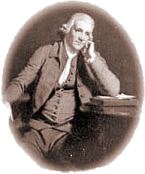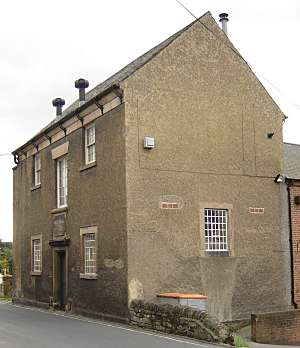
The Unitarian Chapel in Belper appears in the material on this website because it was built on the land where I lived when I began this website. The land at that time was owned by the Stathams of Shottle, who were probably related to the Strutts.
The chapel itself and its construction are dealt with in other places. This page is a short summary of the growth of the Unitarian congregation in Belper.
A recent visitor says: the Unitarian Chapel on Field Row, to the south-east of Long Row, was founded in 1788 by Jedediah Strutt, who was a committed Dissenter. At the time of my visit, former minister Rev. Derek Smith, his wife Pauline and church member Muriel Bolshaw were clearing up after serving refreshments at one of the chapel's monthly open days. Muriel is a relative newcomer to Belper, having lived at one time or another in every Midland shire, but Derek and Pauline were able to act as knowledgeable guides to the beautiful grade II-listed chapel. I learnt that the building's two wings are an extension to the original chapel. Rather surprisingly, one of them was constructed over Jedediah's grave. After these additions, the interior arrangement of the church was then turned through 90 degrees, leaving the pulpit in a central well between banked tiers of box pews in each of the wings. The balcony clock, constructed by John Whitehurst of Derby, is a survival from the original chapel and all the cast-iron pillars closely resemble those in North Mill.
The Beginnings
In 1660, the Church of England was re-established as THE universal faith and power in the land, and thus dissenting people were at a disadvantage.
To quote a short history of non-conformist religion:
"Henry VIII's break from the Pope which began the Reformation in 1537 allowed people to find their own forms of religion that satisfied their own needs and beliefs. To begin with the Reformation caused two new religious groups to be formed. Puritans wanted to reform the practices of the Church of England from within the institution, whilst Separatists could see no way that change was going to occur without leaving and setting up on their own.
By 1567 congregations belonging to these nonconformists groups (also known as Dissenters) began to meet together in private for religious services. These 'Independent' units gave rise to the Congregational Churches, with the Baptists emerging later in 1603. The Presbyterians came into their own during the Civil Wars. Presbyterians were part of the Church of England who had tried to modify the way that the church was governed. In 1662 the Act of Uniformity was passed, which called for all ministers to swear by all that was written in the Common Book of Prayer according to the Church of England. All those who refused to comply were ousted from the Church of England. Presbyterians split further into two groups: Independents and Unitarians."
In Derbyshire, as everywhere else in the land, ejected ministers led small groups that worshipped in their own homes, in secrecy. One of these was Samuel Charles (1635-1693), born at Litton near Tideswell. He was ejected from his living in Mickleover and travelled to Belper to set up a group there. In 1672, by an Act of Toleration, restrictions had been eased, and Charles was registered as a preacher in Belper at that time. However, the religious situation was unsettled for many years afterwards.
In the 17th century, Samuel Charles and his contemporaries were Puritan Calvinists, and very definitely trinitarian. Only later did some Presbyterians become "unitarians" with a change from trinitarian to more liberal beliefs. The Hull Church to which Samuel Charles moved after his stay in Belper has preserved some of his sermons (he arrived around 1680) and they demonstrate his allegiance to Calvinism. (See more information here.)
Up until 1689, the outlook was bleak and dangerous for any who dissented from the official Church in England. Samuel Charles himself was imprisoned:
But the Toleration Act in 1689 allowed the permanent right of non-conformist worship. This meant that preachers could officially be appointed to congregations, and houses could be licensed for worship."After Wilson's death in 1679 the Presbyterian minister was Samuel Charles, ejected in 1662 from Mickleover (Derbys.). Under Charles there was only one meeting-place, possibly already in Bowlalley Lane. (fn. 17) Late in 1682 the governor, the Earl of Plymouth, ordered the suppression of both congregations and, though Astley escaped, Charles was caught in 1683 and imprisoned for six months.
"Several members of the congregations were called before the corporation, including John Robinson, the elder of the Independents, and Christopher Fawthorp, on whose land the Bowlalley Lane Presbyterian chapel was later to be built. After his imprisonment Charles was despatched to Welton under the Five Mile Act. During the next few years dissenters were pursued for not attending their parish church and for keeping conventicles, and few new members were added to the Independent congregation: after 12 had been gained in 1679 there were only 10 all told from 1680 to 1685.(Source)
In that same year therefore, John Taylor - who was a Belper man - applied for registration in 1689. In 1709, George Webster, and in 1714 Joseph Statham (see note**) likewise had their houses licensed for worship. In nearby Shottle, another Statham - William Statham - applied for a license in 1713.
The Belper Presbyterians
The Belper congregation would have been visited in the early years of the 17th century by travelling preachers and ex-ministers of the Church of England who believed in the reform of the system. One of these was William Bagshawe (known as The Apostle of the Peak)
Another Statham (though probably not related) was Samuel Statham from Loughborough who looked after the Belper congregation for two years, from 1708 to 1710. His short stay was probably due to the fact that the Belper dissenters were not able to support their own minister, at least not for long periods of time. Records of the "Common Fund" set up to assist poor non-conformist groups show that Belper struggled financially at that time.
They shared their ministers with congregations in Heage, Duffield and Pentrich. Both Nathaniel Ward (Belper minister from 1712-1749) and his fellow-minister Stephen Parker ministered at Heage.
First Chapel
 It was during the 30-year ministry of Nathaniel Ward, in 1721, that the first purpose-built chapel was erected in Belper. This was a small single-storey building near the centre of Belper (see right - with top storey added.) Clearly, the Presbyterians thrived, as more seating was required by 1740 and galleries were added. It could then contain 250 people.
It was during the 30-year ministry of Nathaniel Ward, in 1721, that the first purpose-built chapel was erected in Belper. This was a small single-storey building near the centre of Belper (see right - with top storey added.) Clearly, the Presbyterians thrived, as more seating was required by 1740 and galleries were added. It could then contain 250 people.
The building survives, and was for many years used by Robey's the heating suppliers. (Currently an Italian Cafe/Restaurant.)
You can still get a feel for the building if you look around in the chapel part of it, and go upstairs to see the shape of the room and the old fireplace there. To see photos, look at the slideshow.
Even after the new Strutt chapel was built, the old building was used for the Sunday School; in 1855 it was extended by the addition of a second storey.
From 1776-1805 a record of baptisms was kept, and the five books have been transcribed on the site. Shortly afterwards, Jedediah Stutt took the story in a new direction.
Strutts Influence
With the arrival of Jedediah Strutt and the building of the mills in Belper, things took an altogether new turn. An impressive new stone chapel was built, this time a lot further out of town. It was situated right in the middle of the block of houses Strutt was erecting for his mills workers and their families, perhaps in an attempt to improve their lives spiritually as well as physically.
The central portion of the chapel had been built by 1789, when a new permanent minister arrived to serve the Belper community. He was George Lee, from Elland in Yorkshire. Lee had abandoned his position on the Trinity and his Calvinim to adopt Unitarianism, and it was under his influence that many of the Belper folk followed suit. (Lee later moved to Hull and became the Editor of the Socialist newspaper, the "Hull Rockingham".)
That some disagreed and held to their former faith is suggested by the presence of a small group of independents meeting in the Old Meeting House (as it now was) in Green Lane from 1790. (They eventually erected their own chapel off Green Lane.) Some names that appear in the Unitarian baptism registers - such as Harrison, Barber and Walker - now show up listed as "independents" in the lists of Protestant Non-conformists, although the title may have covered Presbyterians as well as Congregationalists.
NOTE: (** It is of interest to me that Joseph Statham is related (so I'm told) to the Stathams of Shottle who subsequently owned the house and land on which the chapel was eventually built. At least three sons of that line were either dissenting preachers, or held house meetings. I'm also checking out the claim - made in 1925 - that Joseph Statham's daughter Martha Statham married William Strutt and became the mother of Jedediah Strutt. This fact would go a long way to explaining how the land came into the possession of the Strutts as well as the devout nature of Jedidiah and his siblings.)
Modern Times
The ongoing history of the Chapel is told in various books available on Belper. Some useful sources are:
- "Derbyshire Nonconformity: A Gazetteer" by Stephen Orchard (Derbyshire Family History Society)
- "Non conformism: Chapels and Meetings Houses in Derbyshire" (HMSO publications 1986, ISBN 0113000073)
- "Belper Unitarian Chapel" (booklet available locally, first printing 1978, updated 1994)
Some Web Links are:
- Unitarianism book links
- What is Unitarianism?
- Protestant Dissenters in England
- List of historical documents from the Unitarian Historical Society
- The Hull Dissenters
- William Bagshawe
- William Bagshawe, the Apostle of the Peak
- Unitarian Website
- History of the Belper Unitatian Church (1994 in pdf format)
- Belper Unitarian Chapel Website






